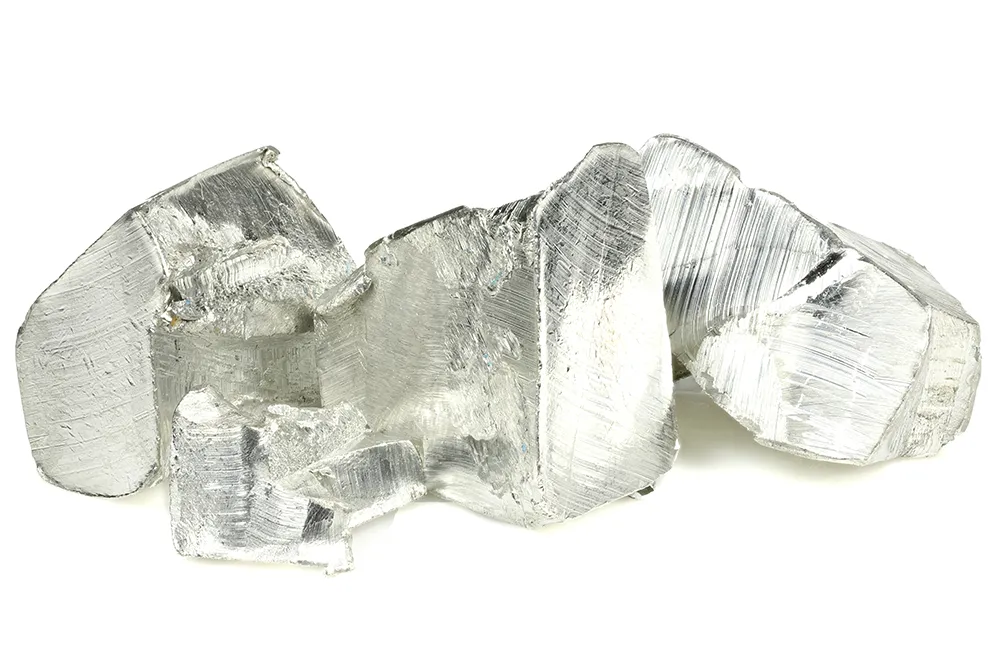What is tin?
As a silvery-white, soft, heavy metal, tin is a component of minerals. The most common tin ore, besides stannite (tin gravel), is cassiterite (tin stone). Tin deposits often contain other mineral resources such as arsenic, tungsten, bismuth, silver, zinc, copper and lithium. The characteristic sound that pure tin makes when bent is remarkable. The so-called tin scream is caused by the friction of the crystallites. The protective oxide layer that coats tin is similar to that of titanium.
If tin is used in the metallurgical production of bronze (alloy with 60% copper), it is called tin bronze. For example, bell bronze with a tin content of around 20% is needed for bell casting. From antiquity to the Middle Ages, the material spread widely through global trade. After a decline, production flourished again in the Middle Ages. The pewterers of the craft guilds produced numerous utilitarian and ornamental objects (e.g. cups, jugs, crockery, pewter figures). In addition to the pewterers, there was traditionally also the itinerant trade of the pewter cleaner. His job was to clean the tarnished (oxidised) household objects with the help of pewter herb, the field horsetail. From the middle of the 19th century – with the industrial production of tin plates – foodstuffs, among other things, were traded in tinned iron sheets, cans, or tubes. Argentin and tinfoil are older names for the tin sheets rolled out thinly and processed into “silver paper” or tinsel.
Even today, tin is a sought-after alloy component – the “Nordic gold” is the alloy of the fifty, twenty and ten-cent euro coins. It comprises 89% copper, 5% aluminium, 5% zinc and 1% tin and thus belongs to the brass alloys. Other alloys with tin content applications are electronic components for medical and safety technology, measuring instruments and aerospace. Tin(II) fluoride is added to toothpaste. Tin dioxide is found in the amalgam of dental fillings. The organic tin compounds in fungicides, wood preservatives and disinfectants are toxic. About three-quarters of the organotin compounds (OZV) produced are processed as PVC stabilisers.
How does tin get into drinking water?
The release of metal from minerals is shallow. Tin and its compounds enter the water cycle mainly through humans, such as wastewater from the electrical industry or unsecured waste incineration plants.
How does tin affect the human body?
Elemental, metallic tin is non-toxic. It is an essential trace element. The daily intake of food is approximately 0.2 mg. Minimal amounts may be added from tin cans or containers containing tin. Tin concentrations up to 300 ppm are well tolerated by the organism, partially absorbed or excreted. Symptoms of poisoning due to excess are vomiting and diarrhoea. Tin deficiency shows itself – according to literary sources – by loss of appetite, hair loss and acne.
Most compounds are not very toxic, but some are very toxic. These include the organotins trialkyl and triphenyltin used in maritime paints (anti-fouling paints). The biocide TBT kept ship hulls free of microorganisms but, at the same time, caused alarming toxic concentrations in seawater. It was banned in the EU in 2003 due to environmental pollution. The use of fungicides in European agriculture has not been allowed since 1998. Other harmful tin compounds were banned in 2010 and 2012.
Entries are detectable in general, house dust and shipyard sediments. The adverse health effects have been documented in various organs (kidney, liver, spleen, bladder) and the central nervous system.
Drinking water polluted by tin: What to do?
The parameter tin is not regulated by the Drinking Water Ordinance. Unwanted tin in raw water can be removed by the public utility company’s water treatment with the help of ion exchangers. Copper pipes are often used in the selection of materials for piping systems. To improve the properties and protect against the water’s pH values below 7.4, the copper pipes are tin-plated on the inside. This reduces corrosion in the copper pipes and suppresses the release of copper into the drinking water.
Test tap water for tin
The waterworks guarantee first-class water quality by the Drinking Water Ordinance up to the house connection. The hygienically perfect and uncontaminated drinking water then passes through the drinking water installations of the house up to the tap. Tin hardly plays a role in drinking water. But various other metals (lead, zinc, copper, nickel, chromium, iron), high water hardness, legionella and other germs can damage the water pipes, pollute the tap water and even endanger health.
A water test can reveal possible pollutant contamination. Well owners should regularly have their well water’s nitrate and phosphate values tested.
A water test from a recognised laboratory like IVARIO can provide precise data on your water quality.

